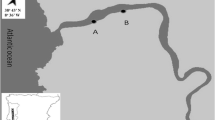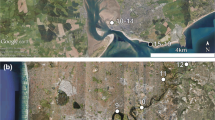Abstract
Examination of the benthic nematode fauna of the soft surface sediments of a turtle grass (Thalassia testudinum König) bed in Biscayne Bay (Miami, Florida) has revealed a high degree of homogeneity exemplified by the dominance of four species out of approximately 100 nematode taxa from the area. The dominant species, Metoncholaimus scissus, Theristus fistulatus, Spirinia parasitifera and Gomphionema typica, regularly comprised between 87 and 95% of the total number of nematodes present in samples collected during the winter and spring of 1966. T. fistulatus showed an abundance of 56% over the course of the study, i.e., 160 samples collected over a period of 14 months. Maximal peaks in population densities were noted and correlated with physiographic alterations in the environment. The M. scissus population declined concurrent with changes in the community; at the same time, with accumulation of sediment, the Terschellingia longicaudata population increased. Ratios of species, and especially shifts in the dominantforms present, with repeated collections, are extremely useful indicators of important biological and physical changes in a particular environment. Analysis of distributional data on dominant species in 64 samples from eight closely approximated positions showed that observed temporal and spatial variations were not significant statistically at the 5% level. It is concluded that erroneous observations can be made from ecological studies based on field data derived without proper replication or consideration of seasonal factors. The latter as well as intrinsic variability within the particular locality itself contribute to the basic faunistic composition of benthic communities.
Similar content being viewed by others
Literature cited
Bastian, C. H.: Monograph of the Anguillulidae or free nematoids, marine, land, and freshwater; with descriptions of 100 new species. Proc. Linn. Soc. Lond. 25, 73–184 (1865).
Cobb, N. A.: Nemic spermatogenesis: with a suggested discussion of simple organisms, — Litobionts. J. Wash. Acad. Sci. 18, 37–50 (1928).
Gause, G. F.: The struggle for existence, 163 pp. Baltimore: Williams and Wilkens Co. 1934.
Gerlach, S. A.: Freilebende Meeresnematoden von den Malediven II: Kieler Meeresforsch. 19, 67–103 (1963).
Hopper, B. E.: Free-living marine nematodes from Biscayne Bay, Florida, II. Oncholaimidae: Descriptions of five new species and one new genus (Meyersia). MSS.
—, and S. P. Meyers: Observations on the bionomics of the marine nematode, Metoncholaimus sp. Nature (Lond.) 209, 889–900 (1966a).
—: Aspects of the life cycle of marine nematodes. Helgoländer wiss. Meeresunters. 13, 444–449 (1966b).
—: Follicolous marine nematodes on turtle grass, Thalassia testudinum König, in Biscayne Bay, Florida. Bull. Mar. Sci. Gulf Caribb. 17, 471–517 (1967).
Meyers, S. P., and B. E. Hopper: Attraction of the marine nematode, Metoncholaimus sp., to fungal substrates. Bull. Mar. Sci. Gulf Caribb. 16, 143–150 (1966).
—: Studies on marine fungal-nematode associations and plant degradation. Helgoländer wiss. Meeresunters. 15, 270–281 (1967).
Schuurmans Stekhoven, J. H.: Additional notes to my monographs on the free-living marine nemas of the Belgian Coast. I and II. Written in collaboration with Adam, W., and L. A. De Coninck, with some remarks on the ecology of Belgian nemas. Mém. Mus. r. Hist. nat. Belg., 36 pp. (1935).
Teal, J. M.: A technique for separating nematodes and small arthropods from marine muds. Limnol. Oceanogr. 5, 341–342 (1960).
Wieser, W.: Free-living marine nematodes. III. Axonolaimoidea and Monhysteroidea. Acta Univ. Lund. 2, 52, 1–115 (1956).
—: Free-living marine nematodes. IV. General Part. Acta Univ. Lund. 2, 55, 1–111 (1959).
— Benthic studies in Buzzards Bay. II. The meiofauna. Limnol. Oceanogr. 5, 121–137 (1960).
—, and B. E. Hopper: The Neotonchinae, new subfamily (Cyatholaimidae: Nematoda) with an analysis of its genera, Neotonchus Cobb, 1933, and Gomphionema new genus. Can. J. Zool. 44, 519–532 (1966).
—: Marine nematodes of the east coast of North America. I. Florida. Bull. Mus. comp.: Zool. Harv. 135, 239–344 (1967).
—, and J. Kanwisher: Ecological and physiological studies on marine nematodes from a small salt marsh near Woods Hole, Massachusetts. Limnol. Oceanogr. 6, 262–270 (1961).
Author information
Authors and Affiliations
Additional information
Communicated by G.L. Voss, Miami
This work was supported by Grant 12482 from the National Institute of Health to the Institute of Marine Science, University of Miami, and is a contribution (No. 819) from the Institute of Marine Science and from the Nematology Section, Entomology Research Institute, Research Branch, Canada Department of Agriculture, Ottawa.
Rights and permissions
About this article
Cite this article
Hopper, B.E., Meyers, S.P. Population studies on benthic nematodes within a subtropical seagrass community. Marine Biol. 1, 85–96 (1967). https://doi.org/10.1007/BF00386510
Accepted:
Issue Date:
DOI: https://doi.org/10.1007/BF00386510




